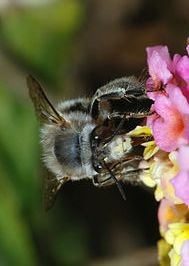Anthophora hispanica
(Anthophora hispanica)

Description
Anthophora hispanica is a bee species first described by Fabricius in 1787. It is part of the genus fur bees and the family long -tongued bees. No subspecies are listed in the Catalog of Life. The species is a large bee with a body length of 18 to 21 mm for males, 19 to 20 mm for females. The face is predominantly yellow, while the base color is otherwise black. The middle body and tergit 1 to 2 (the upper body segment of the upper body) have reddish-brown fur, while the fur on the rest of the hind body is black. The wings have been shown solely to give a sense of proportion. Like everyone in the genus, the species is a solitary bee and a skilled aviator who prefers dry climates. In Israel, the species is a desert bee that occurs in the Negev up to the coastal areas north of it. In that country it flies between March and April. In Egypt, where it occurs in the north, the flight period lasts from March to April. Anthophora hispanica likes to visit desert plants, such as the snow herb Echium angustifolium, the blue monkey Moricandia nitens, the sibling Stachys aegyptiaca and the woodpecker Astragalus spinosus. The bee genus Anthophora is one of the largest in the family Apidae, with over 450 species worldwide in 14 different subgenera. They are most abundant and diverse in the Holarctic and African biogeographic regions. All species are solitary, though many nest in large aggregations. Nearly all species make nests in the soil, either in banks or in flat ground; the larvae develop in cells with waterproof linings and do not spin cocoons. Males commonly have pale white or yellow facial markings, and/or peculiarly modified leg armature and hairs. Anthophora individuals can be distinguished from the very similar genus Amegilla by the possession of an arolium between the tarsal claws. The species occurs in Turkey, Israel, Egypt and Syria. It has also been found in Spain and Portugal.
Taxonomic tree:







